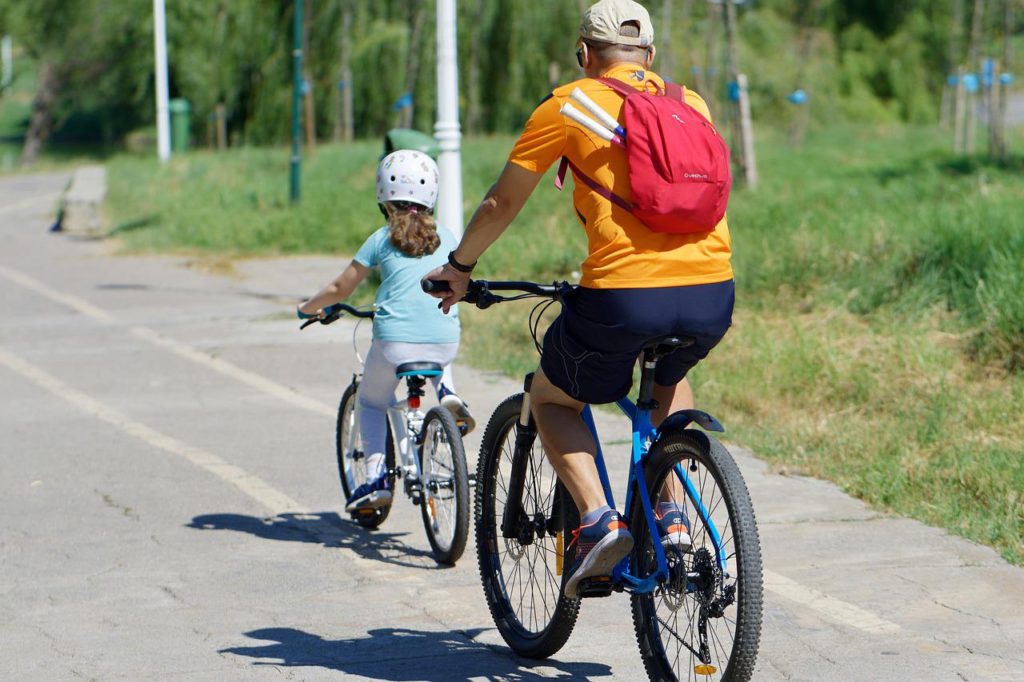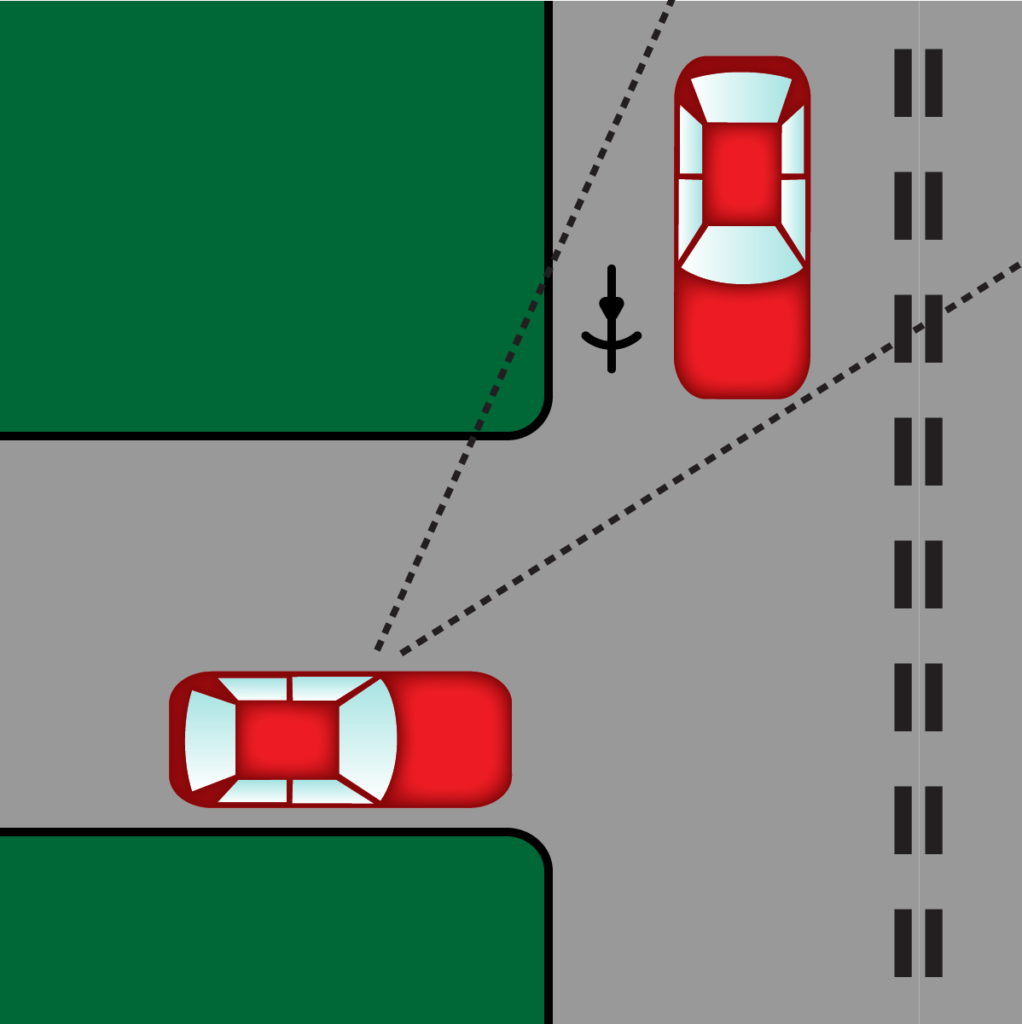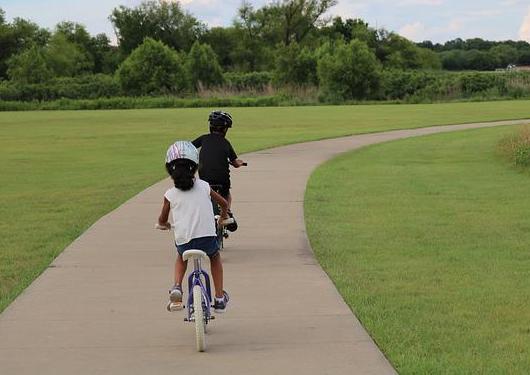
I can hear it happening already. (Me using my best impression of my dad’s voice): “In my day, riding a bike was different.” And while I might weep a little as I slowly turn into a grumpy old man, the truth is, bike riding for my kids today is very different than it was for me (besides riding uphill both ways in the snow…).
There are so many things I love about my childhood, and the freedom I had to ride around my neighborhood was wonderful. Hindsight is 20/20, however, and I know the places I rode my bike that I absolutely should not have gone. I have since learned my lesson, and there are a lot of things my kids are NOT going to do that I once did – like ride their bikes wherever they want, however they want. I’m going to make sure my kids know the proper rules of riding bikes in the street.
That’s when it hit me; I don’t actually know the rules of the road. On what side of the road should my kids ride their bikes? Is it okay for them to ride on the sidewalk? At what point is it alright for them to ride in the street on their own? After many deep dives into local laws and government safety recommendations, I’ve gone and found the answers.
As a rule, children 10 and older should always ride their bikes with the traffic and NEVER against traffic. In the United States, that means riding their bikes on the right side of the road. Children under 10 years old should ride their bikes on sidewalks and paths and avoid riding their bikes near traffic.
Of course the age and bike-riding experience of a child is ultimately what determines where they should ride their bike. An older, more experienced cyclist is expected to follow the rules of the road, whereas younger children or novice bike riders may not be ready to ride their bikes in the road.
Why Should Cyclists Ride With Traffic? (8 Great Reasons)
1. It’s the law
The simplest reason why cyclists should ride with traffic is that it’s illegal to ride against traffic. While local governments usually determine bicycle laws, which could mean many variations and exceptions, most states and municipalities consider a bicycle to be a vehicle. Therefore the rules of the road are the same for a bicycle as they are for a motor vehicle.
From a safety standpoint, and for a number of reasons, it is significantly more dangerous for a cyclist to ride against traffic than with traffic.
2. Motorists aren’t looking for you
One fundamental guideline to bicycle safety in traffic is that if a driver sees you, they are less likely to hit you. When you ride against traffic, you put yourself where drivers aren’t looking for you. Drivers are less likely to see a bicyclist riding against traffic; this is especially true when drivers are entering and leaving roadways and driveways.
If you look at the image below, the driver on the bottom left is going to make a right turn. Since the driver is looking at incoming traffic (to his left), he is going to be much more aware of the cyclist that is riding in the same direction as traffic.

If however, the cyclist was riding in the opposite direction (not illustrated), the driver is much less likely to look to the right, because he is not expecting traffic to come in that direction.
3. Less driver reaction time
A driver has less time to react if it is difficult to see you on the road. If a cyclist is traveling at 20 mph and the car is driving 40 mph, their closing speed when driving with traffic is 20 mph. When the cyclist is driving against traffic, the closing speed is 60 mph–three times faster.
4. You cannot see traffic signs
When you ride against traffic, it is much harder to see traffic signs. Road signs are usually on the side of incoming traffic. When a cyclist rides against traffic, not only is it harder to see road signs, but incoming traffic may block them completely.
5. You’ll be blinded by headlights (at night)
Let’s just stipulate that your kids probably shouldn’t be riding their bikes when it’s super dark, but if they are, it is much harder to see if the headlights of incoming traffic are blinding you. When you ride with traffic you are not directly in the headlights of incoming traffic.
6. You’re more likely to get hit by a door
When you ride with traffic, you are much less likely to get hit by someone opening their car door. Granted this is more for people in urban areas, but generally speaking, when someone is opening their car door into a busy road, their attention is on the side mirror watching incoming traffic. They’re not usually looking the other way because there isn’t a reason to.
7. You’re more likely to hit a pedestrian
This is similar to the image in No. 2. When a pedestrian is looking to cross the road, their immediate attention is on incoming traffic that is closest to them (in the US, that’s to the left). If you are riding against traffic, pedestrians are less likely to look your way.
8. Statistics don’t lie
Finally, if this list isn’t convincing enough, look at the statistics. A recent study showed that on average, there are 3 times more accidents for cyclists who travel against traffic. If you only count accidents for those 17 and under, that number increases to 6 times more accidents for cyclists who travel against traffic. (If you want more statistics, check out this article originally published in the Institute of Transportation Engineers.)
Just don’t do it.
Should Kids Ride on the Sidewalk?
Generally, it is acceptable for children under 10 years old to ride on the sidewalk. Of course this depends on your city. As most bike laws are made on the state and local levels, not at the federal level, there are going to be variations to this rule. A suburb in East Texas is going to have different conditions and therefore different laws than New York City.
It is wise for young and novice bike riders to ride on sidewalks and paths. When they are older and experienced enough to understand the rules of the road, they are then expected to avoid sidewalks and ride in the street. Depending on the municipality, it may even be illegal for a cyclist to ride on the sidewalk.

As a side note, be careful when riding in the middle of a college campus. Many universities have their own regulations about riding on sidewalks in the middle of campus. Their reasoning is that sidewalks are often crowded with pedestrians between classes, making cyclists a potential danger to people walking to class. I’ve heard many students complain about the ticket they received while cycling in the middle of campus.
At What Age Should a Child Ride a Bike on the Road?
As a rule, children should avoid riding in the street until they’re 10 years old. This, of course, is not an absolute as there are so many variations to circumstances. For example, I live in a suburban neighborhood with no sidewalks and our driveway is on slope. If my kids didn’t ride their bikes in the street, they would never get to ride their bikes without us all driving to a parking lot or park.
Often when someone asks this question, they usually mean, “When should a child ride a bike with traffic?” Most children have matured enough at around 10 years old to understand road safety and have had enough cycling experience to manage driving with light traffic. All this being said, I will not allow my kids to ride on certain streets in my town until they well into their teens.
It is important for you to make your own family rules for riding bikes in different circumstances. Make a short list, talk to your kids, and be clear what is expected for different circumstances. While this list isn’t exhaustive, here are some considerations:
- Supervised vs unsupervised bike rides
- Family vs friend bike rides
- Daytime vs night riding
- Group riding vs solo riding
Recent Posts
I mean, we've all done it, right? Ridden your bike all your life in flip flops? When the topic of footwear for bike riding comes up, you’ll hear all sorts of opinions. Some people swear that there...
Teach an Anxious Child to Ride a Bike (In 9 Stress-Free Steps)
I’ve been a teacher for almost 20 years. It’s important to recognize that people learn in different ways and at different speeds. So when you watch that YouTube video that “guarantees” that...
